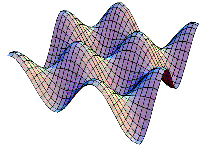 Why We Wrote This Book
Why We Wrote This Book


Mathematica is a system for doing mathematics by computer. -- Stephen Wolfram
That statement encapsulates the vision of Stephen Wolfram, the developer of Mathematica. Mathematica 3 is an ambitious program. It contains hundreds of commands to do mathematics. You can use it to graph functions, solve equations, perform statistical tests, and do much more. In addition, it incorporates word processing and desktop publishing features that allow you to combine mathematical computations with text and graphics and produce a polished, integrated interactive document. You can add sound. You can animate the graphics. You can export Mathematica documents in HTML for use on the World Wide Web.
A program this ambitious contains many features and options. The nine items on the main menu bar of the latest release of Mathematica contain more than 375 items in cascading menus, in addition to the hundreds of commands for doing mathematics. The standard reference (Stephen Wolfram, The Mathematica Book, 3rd edition, Wolfram Media/Cambridge University Press, 1996) is more than 1400 pages long and describes only core Mathematica; a separate book is needed to describe the standard packages that accompany the program.
Mathematica is more than a fancy calculator; it is an extremely useful and versatile tool. Even if you only know a little about Mathematica, you can use it to accomplish wonderful things. The hard part, however, is figuring out which of the hundreds of menu items, hundreds of commands, and thousands of pages of documentation you need to look at to start using it quickly and effectively.
That's where we come in.
 Why We Wrote This Book
Why We Wrote This Book

The goal of this book is to get you started using Mathematica successfully and quickly. We point out the parts of Mathematica you need to know without overwhelming you with details. We help you avoid the rough spots. We give you examples of real uses of Mathematica that you can refer to when you're doing your own work. And we provide a handy reference to the most useful features of Mathematica. When you're finished reading this book, you will be able to use Mathematica effectively. You'll also be ready to explore more of Mathematica on your own.
You might not be a Mathematica expert when you finish this book, but you will be prepared to become one -- if that's what you want. We figure you're probably more interested in being an expert at your own specialty, whether that's finance or physics or psychology or engineering. You want to use Mathematica the way we do, as a tool. This book is designed to help you become a proficient Mathematica user as quickly as possible, so you can get on with the business at hand.
 Who Should Read This Book
Who Should Read This Book

Complete novices, occasional users who want to sharpen their skills, intermediate or experienced users who want to learn about the new features of Mathematica 3, and even experts who want to find out whether we know anything they don't.
You can read through this Primer to learn Mathematica on your own. If your employer (or your professor) has plopped you in front of a computer with Mathematica and told you to learn how to use it, then you'll find the book particularly useful. If you are teaching or taking a course in which you want to use Mathematica as a tool to explore another subject -- whether in mathematics or science or engineering or business or statistics -- this book will make a perfect supplement.
As mentioned, we wrote this Primer for use with Mathematica 3. If you plan to continue using Mathematica 2.2, however, you can still profit from this book. The material on Mathematica commands in Chapters 2, 4--6, and 8 applies to both versions. Only the description of the interface in Chapters 1, 3, and 7 is exclusive to Mathematica 3.
 How This Book Is Organized
How This Book Is Organized

In writing, we used our experience to focus on providing important information as quickly as possible. It contains a short, focused introduction to Mathematica. It contains practice problems (with complete solutions) so you can test your knowledge. There are several sample Notebooks showing you how Mathematica can be used in real-world applications and an entire chapter on troubleshooting.
The core of this book consists of about 80 pages: the section of Chapter 1 for the particular platform you're using, Chapters 2--4, and the beginning of Chapter 5. Read that much and you'll have a good grasp of the fundamentals of Mathematica. Read the rest -- the remainder of the Graphics chapter as well as the chapters on Applications, the Web, Troubleshooting, and the Glossary -- and you'll know enough to do a great deal with Mathematica. You'll also know how to use online resources to enhance your expertise.
[Home] [Cover] [Contents] [Description] [Sample Notebooks]
[Authors] [Publisher] [Availability] [Late News]